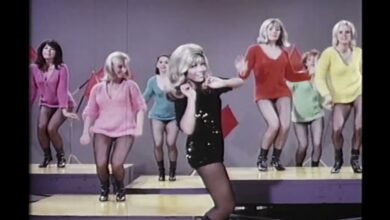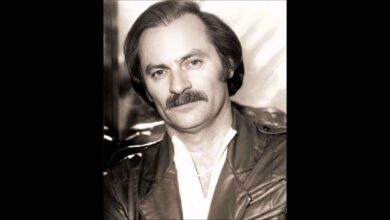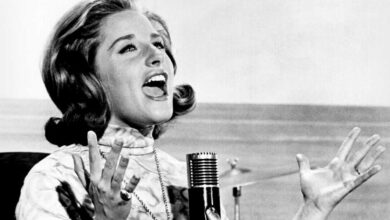The Heartbreak and Legacy of a Timeless Ballad: Roy Orbison’s Unforgettable Performance
In 1961, Roy Orbison released “Crying,” a poignant ballad that showcased his exceptional vocal range and emotive delivery. The song, co-written with Joe Melson, delved into themes of heartache and longing, resonating deeply with audiences and solidifying Orbison’s place in the pantheon of great American songwriters. Its success was marked by its ascent to number two on the Billboard Hot 100 chart, further establishing Orbison’s prominence in the music industry.
Fast forward to March 25, 1965, at the Theater Singer in Laren, The Netherlands, where Orbison’s performance of “Crying” was immortalized during the Monument Concert. This concert was part of a European tour that aimed to bring his music to a broader audience, showcasing his talent beyond American shores. The black-and-white footage from this event captures the essence of Orbison’s stage presence and the emotional depth he brought to his performances.
The Monument Concert of 1965 was a significant event in Orbison’s career. Named after his record label, Monument Records, the concert featured a selection of his most celebrated songs, including “Only the Lonely,” “Running Scared,” and, of course, “Crying.” The choice of venue in The Netherlands highlighted Orbison’s international appeal and the universal language of his music.
During the performance of “Crying,” Orbison’s emotive delivery captivated the audience. His signature sunglasses and stoic demeanor contrasted with the vulnerability expressed in his voice, creating a powerful juxtaposition that left a lasting impression on those in attendance. The live rendition allowed fans to experience the raw emotion of the song in a way that studio recordings could not fully convey.
The 1965 concert was filmed in black and white, a common practice of the era, which added a timeless quality to the footage. The monochromatic visuals emphasized the stark emotions of Orbison’s performance, allowing viewers to focus on the music and the artist’s expressive delivery without the distraction of color. This aesthetic choice has contributed to the enduring appeal of the concert footage.
The setlist for the Monument Concert included a mix of Orbison’s hits and lesser-known tracks, providing a comprehensive showcase of his musical range. Songs like “Dream Baby” and “Mean Woman Blues” highlighted his versatility, while ballads like “Crying” underscored his ability to convey deep emotion. This balanced selection ensured that the concert appealed to both longtime fans and newcomers to his music.
The audience’s reaction to “Crying” during the concert was one of rapt attention and emotional connection. Many attendees were visibly moved, a testament to Orbison’s ability to convey universal feelings of love and loss through his music. This emotional resonance is a key factor in the song’s enduring popularity and its continued impact on listeners.
The Monument Concert was not only a milestone in Orbison’s career but also a reflection of the broader cultural landscape of the 1960s. The era was marked by significant social changes, and music played a crucial role in expressing and shaping public sentiment. Orbison’s heartfelt performances provided a sense of solace and understanding during a time of upheaval.
The technical aspects of the concert’s recording were advanced for the time. The use of high-quality audio equipment ensured that the nuances of Orbison’s voice were captured with clarity, preserving the integrity of his performance for future generations. The decision to film the concert also demonstrated foresight, recognizing the importance of visual media in documenting and sharing musical events.
Over the years, the footage from the Monument Concert has been remastered and re-released, introducing Orbison’s performance to new audiences. These efforts have ensured that the emotional power of “Crying” and other songs from the concert continue to be appreciated, highlighting the timelessness of Orbison’s music.
The legacy of the 1965 performance of “Crying” extends beyond the concert itself. Artists across genres have cited Orbison as an influence, and his emotive style has inspired countless musicians. The live rendition of “Crying” serves as a masterclass in conveying emotion through music, demonstrating the impact that a single performance can have on both audiences and fellow artists.
In analyzing the song “Crying,” it’s evident that its structure and lyrical content contribute to its emotional impact. The gradual build-up in intensity mirrors the experience of escalating heartache, while the repetition of the word “crying” reinforces the theme of overwhelming emotion. This deliberate construction showcases Orbison’s songwriting prowess and his deep understanding of musical storytelling.
The Monument Concert also highlighted Orbison’s unique stage presence. Unlike many performers of the time, he maintained a relatively reserved demeanor, allowing the power of his voice and the content of his songs to take center stage. This approach created an air of mystery and allowed audiences to project their own emotions onto his performances, deepening their connection to the music.
The enduring popularity of “Crying” can also be attributed to its universal themes. Feelings of love, loss, and longing are experiences that transcend cultural and temporal boundaries, allowing the song to resonate with listeners across different backgrounds and eras. This universality is a hallmark of Orbison’s music and a key reason for its lasting appeal.
Reflecting on the 1965 performance of “Crying,” it’s clear that this moment encapsulated the essence of Roy Orbison’s artistry. His ability to convey profound emotion through his music, combined with his distinctive vocal style and stage presence, created a performance that continues to move audiences decades later. The Monument Concert stands as a testament to his enduring legacy in the world of music.



